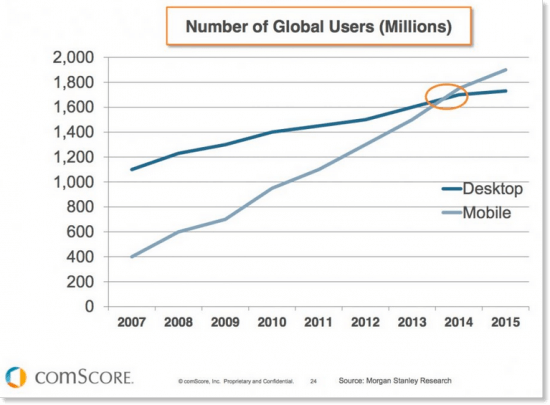Should you move your blog to Medium or Facebook? The post dot-com era for content
Columnist Patrick Armitage takes a look at the trends reshaping content marketing and what the move toward third-party distribution platforms means for marketers.
 We are currently experiencing a content marketing upheaval, the likes of which have never been seen before. Brands are increasingly reliant on third-party platforms for their content and distribution.
We are currently experiencing a content marketing upheaval, the likes of which have never been seen before. Brands are increasingly reliant on third-party platforms for their content and distribution.
These are exciting times — but also uncertain ones. Is this reliance a good thing? A bad thing?
Whatever it is, it’s definitely going to change how we think about the conventions of content strategy.
The latest trends reshaping content marketing
Consider the most recent trends that are changing the conventions of content marketing:
Trend 1: Brands now launch their online presence via social first and their website second.
Clique Media Group (publisher of Who What Wear, Byrdie and My Domaine) launched Obsessee from one landing page with links to their social channels. There was no traditional website. Their content, the content they’ve created to announce the launch of their brand… rolled out on third-party social sites.
“General interest sites should be where the audience is,” Nicholas Carlson, editor-in-chief of Insider, told The Business of Fashion. “Where the audience is these days is on social.”
Trend 2: It’s going to be harder to measure the ROI of your content if you want a first-mover advantage.
Say goodbye to managing all your engagement data on your own site with Google Analytics (at least for now). New media is about the medium first and the metrics second.
Consider the insatiable growth of Snapchat and Instagram gobbling up what’s left of our limited attention span. Snapchat is now becoming impossible for brands to ignore.
And yet, it’s Snapchat’s minimalist interface and even more minimalist measurement tools leaving brand and content marketers scratching their heads. The measurement is so tenuous, we’ve invoked the “count-on-your-fingers methodology” of calculating engagement metrics.
As marketer Everette Taylor says on Buffer:
[blockquote] If you have the time and the patience to count manually, you can calculate new follower metrics and figure out your follow rate — daily, weekly, monthly and even annually. This allows you to set acquisition goals as well.”[/blockquote]
Hmm.
Trend 3: Mobile-first content.

You can look at graphs, or you can do the research anecdotally. Everyone is on their phones. Seemingly all the time.
If I read content on my phone that isn’t optimized for mobile, I don’t save it for later. I move on as quickly as possible.
Fundamentally, your strategy should consider mobile first. Companies taking it a step further, like Quartz, are already experimenting with chat and texting to deliver your content.
The post-dot-com era
Brands and their readers have become platform- and website-agnostic. Third-party marketing channels are replacing owned marketing channels. And Gen Z (those whose ages range from two to 19, with marketers targeting the 11- to 19-year-old demographic) stand at the vanguard of next-gen content consumption.
“Gen Z are not [visiting] dot-coms,” Katherine Power, co-founder and chief executive of Clique Media Group, told The Business of Fashion. “This is a very underserved group as far as great content goes.”
Still don’t believe me? Consider this: 77 percent of BuzzFeed’s “eyeballs” now come from platforms other than its website.
The move to third-party distribution platforms
Tomorrow’s successful content marketing campaigns will happen on third-party distribution platforms instead of owned ones.
Reason 1: Medium’s rise
Medium is making it more attractive, cheaper and easier for brands to uproot their website (and accompanying blog) and move it to the online publishing platform.
A high-profile example of this transition is Bill Simmons’ latest endeavor, The Ringer. The Ringer will be the “first premium content website” to exist on Medium. And I’m guessing it won’t be the last.
A lesser-known example, Free Code Camp, and their post, “We just abandoned our blog for Medium. You probably should, too” showed their posts received better engagement on Medium. Instead of typically reposting their blog to Medium, they decided to move everything over permanently.
The fact that a deep-pocketed publisher like The Ringer and a small startup like Free Code Camp can both use Medium as their website or blog should make anyone in content marketing stand up and take notice.
Consider the advantages, explained by Medium in their post announcing their partnership with The Ringer:
[blockquote]Last fall we talked about how Medium could be an excellent place for bloggers and professional publishers to set up shop and run their operations. We eliminate the need for any investment in tech, provide access to a growing network oriented towards meaningful engagement, and deliver constant, always-on innovation from a world-class product development team, whether you’re a single blogger or a large commercial publication — all for free.[/blockquote]
Currently, I’m in the midst of revamping our BlogMutt blog. The monetary cost is steep when maintaining and building a blog ourselves.
The fact is, if we want to make any changes to our blog, we have to either add programming and development staff or pay an outside agency to make changes. Medium has the development team to roll out new product updates for publishers for free.
But it’s not just the development costs. It’s distribution costs, as well.
Had we built our blog on Medium, we’d be part of a larger ecosystem. There is no newsletter readers have to join. The community already exists.
From Shane O’Leary’s excellent piece, “The distribution conundrum is causing a headache for brands,” he rightly states:
[blockquote]Platforms like Medium, Quora — and to some extent LinkedIn Pulse — offer the single most important ingredient to successful writing: readers. Millions of people are already actively going to these places thinking “I want to read something. With content platforms, new articles are significantly more likely to show up in a given reader’s feed than old articles. So after you publish your article, you are practically guaranteed some audience in the first few hours. This cannot be said for most blogs.[/blockquote]
And another oft-overlooked cost can be the reading experience. Take our company’s blog, for example. If it were hosted on Medium, readers would already know how to navigate our content because they already understand how to navigate Medium.
When we send a reader to our own blog, we have our own experience. Yes, that experience is unique. But is it better?
Reason 2: Facebook’s democratization of mobile-first content
Facebook, and its rollout of Instant Articles, will also change content marketing and presage the shift away from owned to third-party distribution channels.
The biggest reason? Facebook Instant Articles could set the standard for democratizing mobile-first content for the world’s largest social network and largest referrer of traffic to news sites.
Facebook solved two critiques of its service when it launched Instant Articles: slow loading times for viewing content and the content experience differing from brand to brand.
Clicking on an article from one company (that would then send me to their site) would render one type of reading experience, while clicking on an article from another company would render a completely different reading experience. Leaving Facebook puts me at the mercy of a brand’s own UX/UI.
So, like Medium, Facebook is going to create a seamless reading experience for the user regardless of brand or content type. But here’s the rub: It will all happen on Facebook. Not your site. Not your blog. Good for the reader. But good for the publisher?
What happens when Facebook and Medium own your distribution channel? They can shut you down in a moment’s notice, as in the case of The Shade Room.
The Shade Room was shuttered by Facebook for violating IP violations. Whether The Shade Room was right or wrong doesn’t matter. The only thing that matters is if Facebook thinks it’s right or wrong (even if it means sending The Shade Room’s 4.4 million fans elsewhere). This is the double-edged sword of handing over your publishing and distribution rights to a third party.
Fortunately for The Shade Room, they kept their content on their own site, so all was not lost, save for the unparalleled reach of Facebook’s distribution channel.
What do these trends mean for content marketers and publishers?
So let’s look at the words: content marketing. If content is 50 percent of the equation, marketing is the other 50 percent.
Distribution remains a considerable sticking point for content marketers. Anyone can create content, but like any good Communications major will tell you: “The medium is the message.”
I believe that content marketers will be willing to sacrifice owned media and continue transitioning to third-party channels if it allows for access to a larger readership, intuitive UI, faster load times, cheaper design and a more consistent reading experience — especially when the switching costs are practically nil.
It will be interesting to see how companies like Facebook and Medium contend with publishers that run afoul of their user agreements. And it will raise even bigger questions around who owns the content when it’s censored or shut down. For now, in the minds of many, the benefits outweigh the unknowns. But for how long?
Contributing authors are invited to create content for MarTech and are chosen for their expertise and contribution to the search community. Our contributors work under the oversight of the editorial staff and contributions are checked for quality and relevance to our readers. MarTech is owned by Semrush. Contributor was not asked to make any direct or indirect mentions of Semrush. The opinions they express are their own.
Related stories
New on MarTech